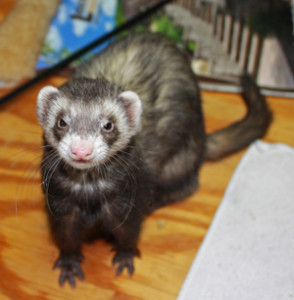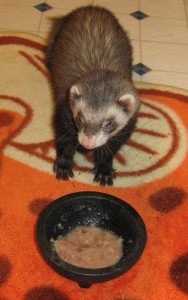Q: Just wondering, what’s the benefit of your custom food mix versus one of the ferret foods out there?
A: We feed high protein, high fat, no grain, low carb — as close to what a carnivore should eat as we
could get. Plant proteins encourage the formation of bladder stones, which is an emergency surgery
situation. Much cheaper to prevent than cure that problem. (Emergency bladder stone surgery runs from
$600 if it happens during normal business hours to $3,000-$5,000 at the emergency vet)
Carnivores don’t need carbs for energy. They can break down the fats for energy. Therefore, carnivores really shouldn’t be fed carbs. A few here and there won’t kill them, but we are very suspicious that high carb diets encourage the disease insulinoma (tumors on the pancreas that produce too much insulin). This causes low blood sugar and that causes weight loss, screaming seizures and death. It can be treated at least for a while with prednisone, but they don’t usually live more than 2 or so years after developing it.
We’ve also found over the years that when we switched to a diet higher in fat and protein, their fur got softer and shinier, a typical sign of good health.
Ferrets really should be eating a whole prey and/or a raw diet, but since they’ve imprinted on kibble as babies, they prefer the kibble. Some people have been successful at switching kibble-fed ferrets to raw, and found remarkable changes in their health.
For example, Joe Rembisz (one of our volunteers), is fostering an elderly ferret named Sasha. When he got her, she was thin and had rather thin fur. She had some energy, but it wasn’t all that great. We figured it was due to her age (6). However, he got her switched to a raw diet (a mix of raw items and freeze dried raw) and she’s gained weight, her fur has come in thick and soft, and she has the energy of a much younger ferret. It takes some work to feed a balanced raw diet, but it’s obviously better for them.
Kibble is easier and most people prefer it, so we try to feed the best blend we can. Orijen cat/kitten chicken is a very high quality kibble. EVO dog little bites chicken is also in our mix. We are watching EVO closely, though, as the company has been sold twice and who knows what they’ll be putting into it. It’s less expensive, though, and when you’re trying to feed 25 ferrets, cost has to be a consideration. The list of foods we don’t consider worth feeding is much longer than the list we would consider using. Nothing with corn, wheat, soy at all. Rice, maybe, depending on where it is in the list. Peas have been causing bladder stones in some ferrets, so we don’t use anything with peas higher than 6th on the list. Orijen is supposed to be produced in the US soon. We’re going to keep our eye on the ingredient list.
Check out the exhaustive list called the More Dooks Food Chart. We don’t usually feed anything other than foods in the GREEN section.




